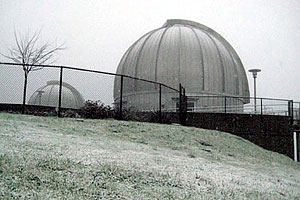 Terrestrial snow at Chabot on December 16, 2008
Terrestrial snow at Chabot on December 16, 2008
Photo by Craig CoryellDriving to work today, I was amused to notice that the raindrops falling on my windshield were a bit grainy--and getting more so the higher up the hill I drove. I starting to think, is it starting to sleet? By the time I reached Chabot--at 1500 feet elevation--the precipitation had turned to bona fide snow!
This is quite unusual for the Oakland Hills, of course. In the ten years I've worked here, this is the second, maybe third, dusting I've witnessed. I recall the great freeze of '74, when it actually snowed in Oakland close to sea level---that's the year all the eucalyptus in the hills froze and died.
My mind wandered---pretty far out in space (an occupational hazard at Chabot). I started thinking about all the recent news and discoveries from around the Solar System, my thoughts guided by the fat white flakes drifting down all around the observatory domes.
Last September, NASA's Mars Phoenix Lander detected snow falling high in the atmosphere--about 4 kilometers high. This Martian snow, however, quickly evaporated in Mars' thin, dry air, never reaching the ground. Phoenix used a laser probe to make the detection--so we don't actually have picture to look at!
Snows of the Solar System may also fall out of the plumes of "cryovolcanoes"--the frigid outer Solar System's version of volcanism (may it live long and prosper). On moons such as Saturn's Enceladus and Neptune's Triton, plumes of material have been detected spouting from fissures and cracks--probably fueled by heat generated by tidal forces from their parent planets.
